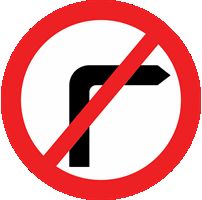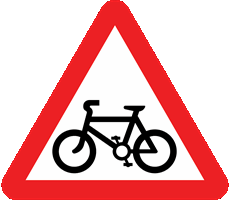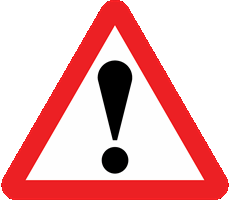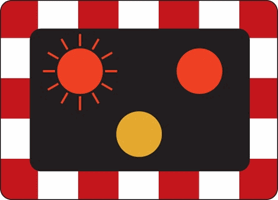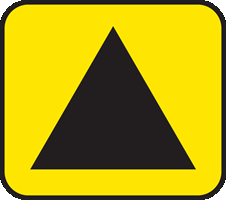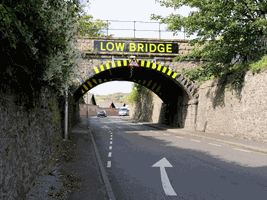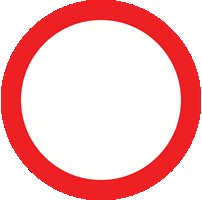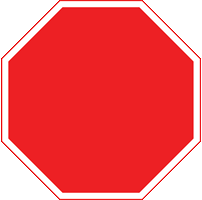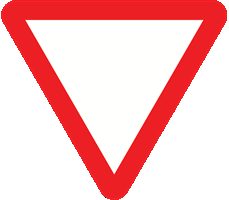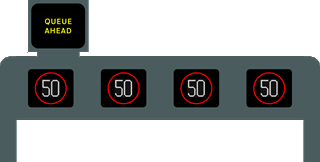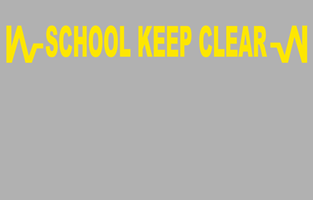This mock driving theory test consists of 50 official questions.
You need 43 out of 50 (86%) to pass. You have a time limit of 57 minutes.
Read more about the theory test and how it works.
There are no tests related to this category :
There are no tests related to this category :
Quick view of test questions. Click question box to reveal correct answer.
A
B
C
D
B
C
D
Correct Answer: B
Explanation: Using a mobile phone or a similar device while driving or riding is against the law, except in the case of an emergency. For your safety, you should switch off your mobile phone before leaving and set it to voice mail. If your phone rings because you forgot to turn it off, ignore it. When you've come to a safe stop, you can check your phone and, if necessary, return the call.
Explanation: Using a mobile phone or a similar device while driving or riding is against the law, except in the case of an emergency. For your safety, you should switch off your mobile phone before leaving and set it to voice mail. If your phone rings because you forgot to turn it off, ignore it. When you've come to a safe stop, you can check your phone and, if necessary, return the call.
Correct Answer: D
Explanation: You should not sound your horn in built-up areas between 11:30pm and 7am, unless another road user poses a danger. You also shouldn't rev your engine unnecessarily between these times. Aim to prevent excessive noise at night.
Explanation: You should not sound your horn in built-up areas between 11:30pm and 7am, unless another road user poses a danger. You also shouldn't rev your engine unnecessarily between these times. Aim to prevent excessive noise at night.
Correct Answer: C
Explanation: Traffic-calming measures such as road humps, chicanes, and narrowings are designed to keep speeds low in areas with high numbers of pedestrians. The survival chances for a pedestrian hit by a vehicle at 20 mph are considerably higher than one hit by a vehicle at 40 mph.
Explanation: Traffic-calming measures such as road humps, chicanes, and narrowings are designed to keep speeds low in areas with high numbers of pedestrians. The survival chances for a pedestrian hit by a vehicle at 20 mph are considerably higher than one hit by a vehicle at 40 mph.
4. As you approach this bridge, which type of vehicle might you meet in the middle of the road?
Mark one answer
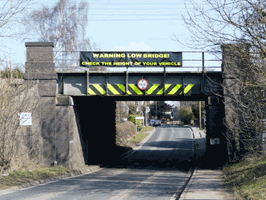
B
C
D
Correct Answer: C
Explanation: Lorries often have to use the centre of the road when passing beneath bridges like this. If this is the case as you approach, give way to them and don't attempt to pass at the same time.
Explanation: Lorries often have to use the centre of the road when passing beneath bridges like this. If this is the case as you approach, give way to them and don't attempt to pass at the same time.
Correct Answer: A
Explanation: The 'stop' sign has been placed here to encourage proper observation. The view onto the main road is obstructed, so you should stop and take time to thoroughly check your surroundings.
Explanation: The 'stop' sign has been placed here to encourage proper observation. The view onto the main road is obstructed, so you should stop and take time to thoroughly check your surroundings.
Correct Answer: C
Explanation: While driving, it's mandatory to obey stop signals from police officers, traffic officers and wardens, and school crossing patrols. It is an offence not to stop when signalled to.
Explanation: While driving, it's mandatory to obey stop signals from police officers, traffic officers and wardens, and school crossing patrols. It is an offence not to stop when signalled to.
Correct Answer: A
Explanation: This is a 'no right turn' sign. It may be that turning right at the junction would be particularly dangerous, or that the adjoining road is a one-way road.
Explanation: This is a 'no right turn' sign. It may be that turning right at the junction would be particularly dangerous, or that the adjoining road is a one-way road.
Correct Answer: B
Explanation: Circular, blue signs provide instructions. You'll find them ahead of mini-roundabouts, and with arrows on them giving directions.
Explanation: Circular, blue signs provide instructions. You'll find them ahead of mini-roundabouts, and with arrows on them giving directions.
Correct Answer: D
Explanation: This indicates a contraflow bus lane. Road markings nearby will also warn of the same thing. You shouldn't park or overtake in this lane.
Explanation: This indicates a contraflow bus lane. Road markings nearby will also warn of the same thing. You shouldn't park or overtake in this lane.
Correct Answer: A
Explanation: This sign indicates there is a cycle route ahead. This usually means bicycles will be kept separate from the main flow of traffic, but watch out for cyclists re-joining when the route ends.
Explanation: This sign indicates there is a cycle route ahead. This usually means bicycles will be kept separate from the main flow of traffic, but watch out for cyclists re-joining when the route ends.
Correct Answer: A
Explanation: This sign warns you of possible danger ahead. A second sign might warn of the specific hazard. In either scenario, be aware that you might have to adjust your course or speed, or even stop.
Explanation: This sign warns you of possible danger ahead. A second sign might warn of the specific hazard. In either scenario, be aware that you might have to adjust your course or speed, or even stop.
Correct Answer: B
Explanation: This sign indicates that there is no through route ahead. It is a dead end, cul-de-sac, or isolated road system.
Explanation: This sign indicates that there is no through route ahead. It is a dead end, cul-de-sac, or isolated road system.
Correct Answer: A
Explanation: Wherever they appear, these flashing red lights mean you should stop even if the way ahead looks clear. You'll find them at level crossings, lifting or swing bridges, as well as at emergency access sites and airfields.
Explanation: Wherever they appear, these flashing red lights mean you should stop even if the way ahead looks clear. You'll find them at level crossings, lifting or swing bridges, as well as at emergency access sites and airfields.
A
B
C
D
B
C
D
Correct Answer: B
Explanation: Police officers wanting you to stop will flash their lights, indicate left, and point left to get you to pull over. It is mandatory to obey signals from police officers.
Explanation: Police officers wanting you to stop will flash their lights, indicate left, and point left to get you to pull over. It is mandatory to obey signals from police officers.
Correct Answer: A
Explanation: These symbols indicate different diversion routes. Look for the symbol on the initial diversion sign, then follow signs with that symbol (a black square, circle, diamond, or triangle) on a yellow background to follow the diversion.
Explanation: These symbols indicate different diversion routes. Look for the symbol on the initial diversion sign, then follow signs with that symbol (a black square, circle, diamond, or triangle) on a yellow background to follow the diversion.
Correct Answer: C
Explanation: Checking the tyre pressures while tyres are cold gives a more accurate reading. Warm tyres - whether due to weather or long-distance driving - will show increased internal pressure.
Explanation: Checking the tyre pressures while tyres are cold gives a more accurate reading. Warm tyres - whether due to weather or long-distance driving - will show increased internal pressure.
17. What should you do if you want to turn left ahead but you are behind a slow-moving moped?
Mark one answer
AB
C
D
Correct Answer: C
Explanation: You should wait to turn until after the moped has passed the junction. Overtaking the moped and taking the junction will mean you've cut across them, potentially forcing them to slow or stop, or causing them to lose control. Only turn when you can do so without affecting the rider.
Explanation: You should wait to turn until after the moped has passed the junction. Overtaking the moped and taking the junction will mean you've cut across them, potentially forcing them to slow or stop, or causing them to lose control. Only turn when you can do so without affecting the rider.
18. What should the driver of the red car do upon seeing the pedestrian crossing the road?
Mark one answer
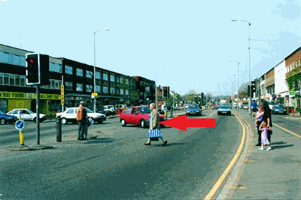
B
C
D
Correct Answer: B
Explanation: It's not uncommon for older pedestrians or those with disabilities to take longer crossing the road. If you encounter a situation like this, you should slow down or stop to allow them to finish crossing. Remain calm and don't show any impatience. Additionally, don't signal for any waiting pedestrians to cross, as this could create potentially hazardous situations where other drivers haven't seen your signal and don't notice the pedestrian.
Explanation: It's not uncommon for older pedestrians or those with disabilities to take longer crossing the road. If you encounter a situation like this, you should slow down or stop to allow them to finish crossing. Remain calm and don't show any impatience. Additionally, don't signal for any waiting pedestrians to cross, as this could create potentially hazardous situations where other drivers haven't seen your signal and don't notice the pedestrian.
Correct Answer: B
Explanation: High-sided vehicles like lorries and buses often need to move the centre of the road to pass beneath bridges like this. You won't be able to fit through at the same time, so you should slow down or stop to allow them through first.
Explanation: High-sided vehicles like lorries and buses often need to move the centre of the road to pass beneath bridges like this. You won't be able to fit through at the same time, so you should slow down or stop to allow them through first.
20. What should you do if a police car behind you flashes its headlights and the police officer points left?
Mark one answer
AB
C
D
Correct Answer: C
Explanation: If a police car behind flashes its headlights and the officer points left, you should pull over somewhere safe and turn off your engine.
Explanation: If a police car behind flashes its headlights and the officer points left, you should pull over somewhere safe and turn off your engine.
Correct Answer: D
Explanation: As with other warning signs, 'give way' signs are triangular. But unlike other warning signs, the triangle is inverted, pointing down. This means that even if the sign is obscured (by snow, for example) you still know what it means. You must give way to traffic on the road you're about to join when you see this sign.
Explanation: As with other warning signs, 'give way' signs are triangular. But unlike other warning signs, the triangle is inverted, pointing down. This means that even if the sign is obscured (by snow, for example) you still know what it means. You must give way to traffic on the road you're about to join when you see this sign.
Correct Answer: B
Explanation: This sign warns of a mini-roundabout ahead. Look for signs indicating which lane you need to use for your desired exit, and ensure you move into the correct lane early, signalling appropriately.
Explanation: This sign warns of a mini-roundabout ahead. Look for signs indicating which lane you need to use for your desired exit, and ensure you move into the correct lane early, signalling appropriately.
Correct Answer: A
Explanation: Only in genuine emergencies is it permitted to use the hard shoulder. If you suffer a breakdown and need to use it, make use of a roadside telephone to call for help. Roadside telephones give the operator your exact location. You shouldn't ever cross a slip road the carriageway to use a roadside phone.
Explanation: Only in genuine emergencies is it permitted to use the hard shoulder. If you suffer a breakdown and need to use it, make use of a roadside telephone to call for help. Roadside telephones give the operator your exact location. You shouldn't ever cross a slip road the carriageway to use a roadside phone.
Correct Answer: A
Explanation: Cyclists and motorcyclists often steer around drain covers in the wet because they prevent a skid risk, and could cause them to lose their balance or even fall. Watch for these hazards as you drive, and learn to anticipate the actions required of different vehicles in different conditions. Cyclists and motorcyclists are also warier of potholes, and will move to avoid them.
Explanation: Cyclists and motorcyclists often steer around drain covers in the wet because they prevent a skid risk, and could cause them to lose their balance or even fall. Watch for these hazards as you drive, and learn to anticipate the actions required of different vehicles in different conditions. Cyclists and motorcyclists are also warier of potholes, and will move to avoid them.
A
B
C
D
B
C
D
Correct Answer: D
Explanation: Keeping the details on your vehicle registration certificate (V5C) up to date is your responsibility, and you need to inform the DVLA of any changes. Failing to do this might make selling your vehicle difficult. Details on the V5C include your name, address, and vehicle details.
Explanation: Keeping the details on your vehicle registration certificate (V5C) up to date is your responsibility, and you need to inform the DVLA of any changes. Failing to do this might make selling your vehicle difficult. Details on the V5C include your name, address, and vehicle details.
Correct Answer: A
Explanation: This sign indicates that all lanes - including the hard shoulder - are open as running lanes but have a compulsory speed limit of 50 mph. When driving on the hard shoulder like this, look as far ahead as you can for obstructions, as the hard shoulder will still be used for breakdowns and emergencies.
Explanation: This sign indicates that all lanes - including the hard shoulder - are open as running lanes but have a compulsory speed limit of 50 mph. When driving on the hard shoulder like this, look as far ahead as you can for obstructions, as the hard shoulder will still be used for breakdowns and emergencies.
Correct Answer: C
Explanation: Variable message signs (usually overhead or on the walls) give instructions and warnings about tunnel traffic conditions. Keep watch for the signs changing, and be prepared to stop if they warn of a hazard ahead. Incidents can quickly spiral out of control in congested tunnels, so be wary.
Explanation: Variable message signs (usually overhead or on the walls) give instructions and warnings about tunnel traffic conditions. Keep watch for the signs changing, and be prepared to stop if they warn of a hazard ahead. Incidents can quickly spiral out of control in congested tunnels, so be wary.
Correct Answer: A
Explanation: Casualties could have internal injuries or other hidden ailments. Moving them could make these worse, and so casualties should not be moved unless staying put presents a danger. Additionally, only if it's absolutely necessary should a motorcyclist's helmet be removed.
Explanation: Casualties could have internal injuries or other hidden ailments. Moving them could make these worse, and so casualties should not be moved unless staying put presents a danger. Additionally, only if it's absolutely necessary should a motorcyclist's helmet be removed.
A
B
C
D
B
C
D
Correct Answer: D
Explanation: Further collision and vehicle fire are the two most immediate dangers. Warn other traffic by turning on your hazard warning lights (and by placing an advance warning triangle anywhere but on a motorway) and turn off engines to reduce risk of fire. Don't put yourself at risk doing this.
Explanation: Further collision and vehicle fire are the two most immediate dangers. Warn other traffic by turning on your hazard warning lights (and by placing an advance warning triangle anywhere but on a motorway) and turn off engines to reduce risk of fire. Don't put yourself at risk doing this.
30. Following a collision, a motorcyclist is injured and unconscious. Why shouldn't you remove their helmet?
Mark one answer
AB
C
D
Correct Answer: D
Explanation: Removing a motorcyclist's helmet could make their injuries more serious. You should only attempt to remove their helmet if absolutely necessary. Likewise, you should avoid moving anyone injured unless staying put presents a danger.
Explanation: Removing a motorcyclist's helmet could make their injuries more serious. You should only attempt to remove their helmet if absolutely necessary. Likewise, you should avoid moving anyone injured unless staying put presents a danger.
Correct Answer: B
Explanation: Driver error is usually the cause of a skid. You should match your driving style to the weather conditions and the type of road you're driving.
Explanation: Driver error is usually the cause of a skid. You should match your driving style to the weather conditions and the type of road you're driving.
Correct Answer: B
Explanation: Gravity will cause your vehicle to pick up speed when travelling downhill, making stopping more difficult. Select a lower gear to employ engine braking, helping keep your vehicles speed under control without risking overheating your brakes.
Explanation: Gravity will cause your vehicle to pick up speed when travelling downhill, making stopping more difficult. Select a lower gear to employ engine braking, helping keep your vehicles speed under control without risking overheating your brakes.
33. You're stopped at traffic lights behind this cyclist. What should you do when the lights turn green?
Mark one answer
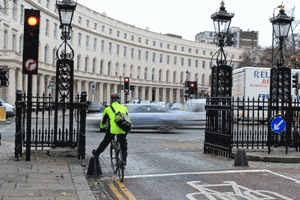
B
C
D
Correct Answer: A
Explanation: You should give the cyclist time and space to pull away. You'll notice specially marked areas at some junctions that allow cyclists to move off ahead of queuing traffic.
Explanation: You should give the cyclist time and space to pull away. You'll notice specially marked areas at some junctions that allow cyclists to move off ahead of queuing traffic.
34. During which of these manoeuvres would you be permitted to remove your seatbelt?
Mark one answer
AB
C
D
Correct Answer: D
Explanation: While reversing, you are permitted to remove your seatbelt to get a better view of the area behind your vehicle. Remember to buckle the seatbelt again before moving off forwards.
Explanation: While reversing, you are permitted to remove your seatbelt to get a better view of the area behind your vehicle. Remember to buckle the seatbelt again before moving off forwards.
Correct Answer: D
Explanation: The white line to the left indicates the edge of the carriageway. You can use this on many roads to judge your position in poor visibility. Be aware that the line will break at lay-bys, private drives, and junctions.
Explanation: The white line to the left indicates the edge of the carriageway. You can use this on many roads to judge your position in poor visibility. Be aware that the line will break at lay-bys, private drives, and junctions.
36. Which part of your car may be damaged by turning the steering wheel while stationary?
Mark one answer
AB
C
D
Correct Answer: D
Explanation: Dry steering - turning the steering wheel while stationary - can cause unnecessary wear to the steering mechanism and tyres.
Explanation: Dry steering - turning the steering wheel while stationary - can cause unnecessary wear to the steering mechanism and tyres.
Correct Answer: A
Explanation: Ideally, you shouldn't leave valuables in your car, but if you have to, locking them away out of sight can deter opportunistic thieves.
Explanation: Ideally, you shouldn't leave valuables in your car, but if you have to, locking them away out of sight can deter opportunistic thieves.
Correct Answer: A
Explanation: Parking on yellow zigzag lines outside schools is never permitted. These are not areas for dropping off or collecting passengers. This area should be kept clear to ensure both drivers and pedestrians have unobstructed views of the road and pavement.
Explanation: Parking on yellow zigzag lines outside schools is never permitted. These are not areas for dropping off or collecting passengers. This area should be kept clear to ensure both drivers and pedestrians have unobstructed views of the road and pavement.
Correct Answer: B
Explanation: If you have one, a garage is the safest place to keep your car. This will protect your car from both potential thieves and the elements.
Explanation: If you have one, a garage is the safest place to keep your car. This will protect your car from both potential thieves and the elements.
Correct Answer: A
Explanation: You should use dipped headlights when driving on busy motorways. Your full-beam headlights will dazzle both drivers ahead of you and those on the other side of the motorway. Dipped headlights should ensure others aren't dazzled.
Explanation: You should use dipped headlights when driving on busy motorways. Your full-beam headlights will dazzle both drivers ahead of you and those on the other side of the motorway. Dipped headlights should ensure others aren't dazzled.
A
B
C
D
B
C
D
Correct Answer: D
Explanation: You should only turn off your headlights on a motorway following a breakdown where you've stopped on the hard shoulder. Leave your sidelights on so other drivers can see your vehicle.
Explanation: You should only turn off your headlights on a motorway following a breakdown where you've stopped on the hard shoulder. Leave your sidelights on so other drivers can see your vehicle.
42. On a motorway, what does it mean if the vehicle in front of you switches on its hazard warning lights for a short period of time?
Mark one answer
AB
C
D
Correct Answer: C
Explanation: Signs above or beside the motorway will warn you of upcoming exits a mile before they appear.
Explanation: Signs above or beside the motorway will warn you of upcoming exits a mile before they appear.
43. You have broken down on a motorway and must use the emergency telephone. What will you be asked for?
Mark one answer
AB
C
D
Correct Answer: D
Explanation: While on the emergency telephone, the operator will ask for your vehicle details and the reason for the breakdown. Whilst on the phone to the operator, you should face traffic so you can see what's coming.
Explanation: While on the emergency telephone, the operator will ask for your vehicle details and the reason for the breakdown. Whilst on the phone to the operator, you should face traffic so you can see what's coming.
44. You're in traffic. When should you signal if you want to pull up on the left just after a junction on the left?
Mark one answer
AB
C
D
Correct Answer: A
Explanation: You should signal just as you pass the junction, or just after passing it. Signalling early might cause other drivers to think you're turning into the junction, and indicating late might leave other drivers with little time to react to you pulling over. Signal at the right time to ensure you don't mislead other drivers.
Explanation: You should signal just as you pass the junction, or just after passing it. Signalling early might cause other drivers to think you're turning into the junction, and indicating late might leave other drivers with little time to react to you pulling over. Signal at the right time to ensure you don't mislead other drivers.
Correct Answer: B
Explanation: You should use your hazard warning lights to warn traffic behind you of danger ahead on a motorway. They should also be used when your vehicle is causing an obstruction following a breakdown.
Explanation: You should use your hazard warning lights to warn traffic behind you of danger ahead on a motorway. They should also be used when your vehicle is causing an obstruction following a breakdown.
A
B
C
D
B
C
D
Correct Answer: C
Explanation: Dipping your mirror (also known as putting it inti the 'anti-dazzle' position) can help stop lights from traffic behind dazzling you. Dipping your mirror still lets you see behind you, but reduces the glare of any lights from behind.
Explanation: Dipping your mirror (also known as putting it inti the 'anti-dazzle' position) can help stop lights from traffic behind dazzling you. Dipping your mirror still lets you see behind you, but reduces the glare of any lights from behind.
47. Why is it potentially dangerous to leave rear fog lights switched on when they're not required?
Mark one answer
AB
C
D
Correct Answer: B
Explanation: Other drivers might think your rear fog lights are your brake lights if you use them in clear weather, and might misunderstand what you're doing. They can also dazzle drivers behind, distracting them from driving safely, particularly at night, in wet conditions, and on motorways. It is illegal to drive in good conditions with fog lights turned on.
Explanation: Other drivers might think your rear fog lights are your brake lights if you use them in clear weather, and might misunderstand what you're doing. They can also dazzle drivers behind, distracting them from driving safely, particularly at night, in wet conditions, and on motorways. It is illegal to drive in good conditions with fog lights turned on.
Correct Answer: A
Explanation: Questioning the actions of other road users is defensive driving, and can help you predict possible hazards and react accordingly. The opposite driving style is competitive driving. This increases the risk of collision for all other nearby road users.
Explanation: Questioning the actions of other road users is defensive driving, and can help you predict possible hazards and react accordingly. The opposite driving style is competitive driving. This increases the risk of collision for all other nearby road users.
Correct Answer: B
Explanation: The Pass Plus scheme is designed to enhance the skills of new drivers. It teaches motorway driving and night-time driving, widening your experience. Completing a Pass Plus scheme can result in lower insurance costs.
Explanation: The Pass Plus scheme is designed to enhance the skills of new drivers. It teaches motorway driving and night-time driving, widening your experience. Completing a Pass Plus scheme can result in lower insurance costs.
Correct Answer: A
Explanation: It pays to be prepared, and having a first aid kit and fire extinguisher on-board could even save lives.
Explanation: It pays to be prepared, and having a first aid kit and fire extinguisher on-board could even save lives.



